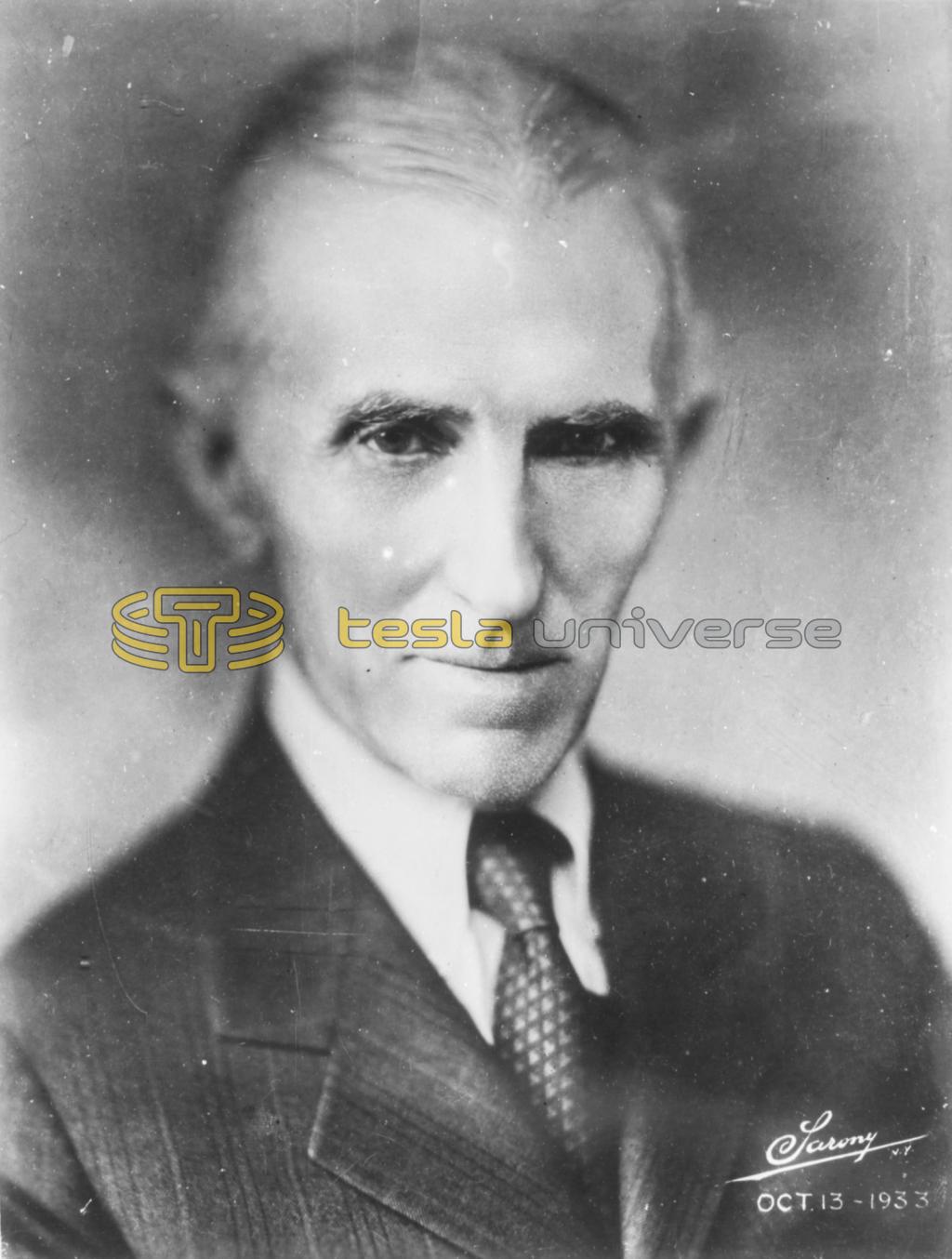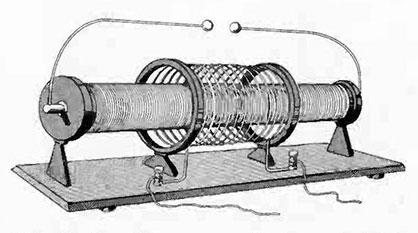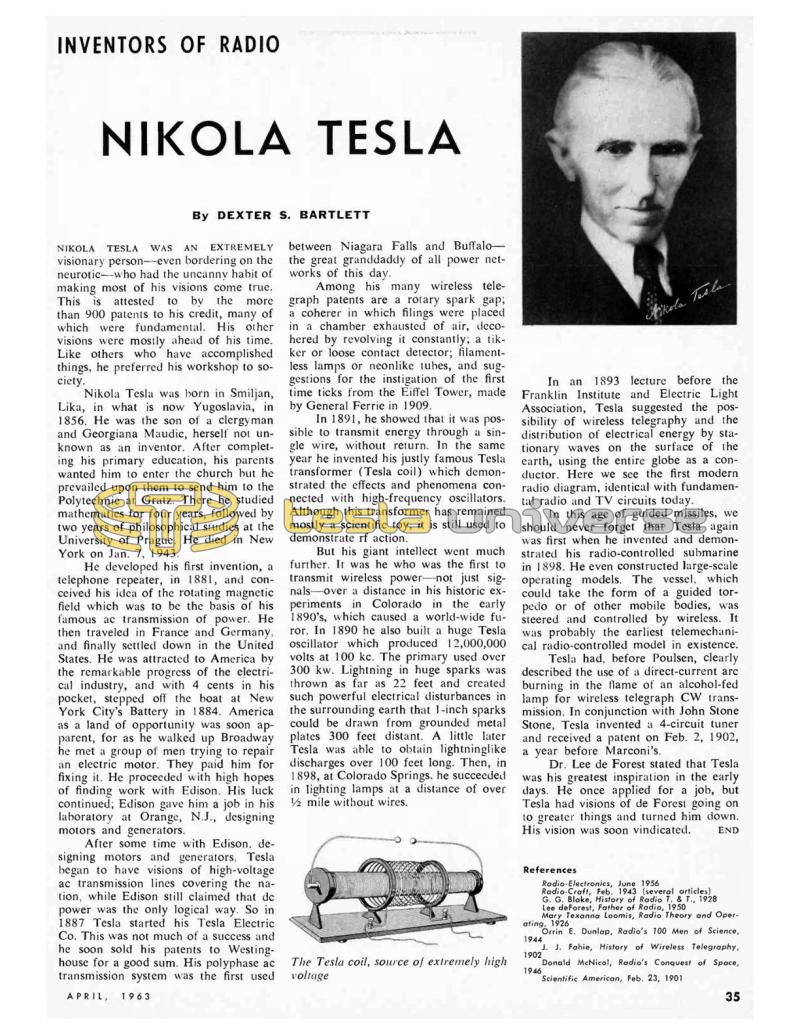
Nikola Tesla Articles
Inventors of Radio - Nikola Tesla
Webmaster note: This article contains errors and inaccuracies. It is represented here, unedited, for historical purposes.
Nikola Tesla was an extremely visionary person — even bordering on the neurotic — who had the uncanny habit of making most of his visions come true. This is attested to by the more than 900 patents to his credit, many of which were fundamental. His other visions were mostly ahead of his time. Like others who have accomplished things, he preferred his workshop to society.
Nikola Tesla was born in Smiljan, Lika, in what is now Yugoslavia, in 1856. He was the son of a clergyman and Georgiana Maudic, herself not unknown as an inventor. After completing his primary education, his parents wanted him to enter the church but he prevailed upon them to send him to the Polytechnic at Gratz. There he studied mathematics for four years, followed by two years of philosophical studies at the University of Prague. He died in New York on Jan. 7, 1943.
He developed his first invention, a telephone repeater, in 1881, and conceived his idea of the rotating magnetic field which was to be the basis of his famous ac transmission of power. He then traveled in France and Germany, and finally settled down in the United States. He was attracted to America by the remarkable progress of the electrical industry, and with 4 cents in his pocket, stepped off the boat at New York City's Battery in 1884. America as a land of opportunity was soon apparent, for as he walked up Broadway he met a group of men trying to repair an electric motor. They paid him for fixing it. He proceeded with high hopes of finding work with Edison. His luck continued; Edison gave him a job in his laboratory at Orange, N.J., designing motors and generators.
After some time with Edison, designing motors and generators, Tesla began to have visions of high-voltage ac transmission lines covering the nation, while Edison still claimed that dc power was the only logical way. So in 1887 Tesla started his Tesla Electric Co. This was not much of a success and he soon sold his patents to Westinghouse for a good sum. His polyphase ac transmission system was the first used between Niagara Falls and Buffalo — the great granddaddy of all power networks of this day.
Among his many wireless telegraph patents are a rotary spark gap; a coherer in which filings were placed in a chamber exhausted of air, decohered by revolving it constantly; a tikker or loose contact detector; filamentless lamps or neonlike tubes, and suggestions for the instigation of the first time ticks from the Eiffel Tower, made by General Ferrie in 1909.
In 1891, he showed that it was possible to transmit energy through a single wire, without return. In the same year he invented his justly famous Tesla transformer (Tesla coil) which demonstrated the effects and phenomena connected with high-frequency oscillators. Although this transformer has remained mostly a scientific toy, it is still used to demonstrate rf action.
But his giant intellect went much further. It was he who was the first to transmit wireless power — not just signals — over a distance in his historic experiments in Colorado in the early 1890's, which caused a world-wide furor. In 1890 he also built a huge Tesla oscillator which produced 12,000,000 volts at 100 kc. The primary used over 300 kw. Lightning in huge sparks was thrown as far as 22 feet and created such powerful electrical disturbances in the surrounding earth that 1-inch sparks could be drawn from grounded metal plates 300 feet distant. A little later Tesla was able to obtain lightninglike discharges over 100 feet long. Then, in 1898, at Colorado Springs, he succeeded in lighting lamps at a distance of over 1/2 mile without wires.
In an 1893 lecture before the Franklin Institute and Electric Light Association, Tesla suggested the possibility of wireless telegraphy and the distribution of electrical energy by stationary waves on the surface of the earth, using the entire globe as a conductor. Here we see the first modern radio diagram, identical with fundamental radio and TV circuits today.
Tesla had, before Poulsen, clearly described the use of a direct-current arc burning in the flame of an alcohol-fed lamp for wireless telegraph CW transmission. In conjunction with John Stone Stone, Tesla invented a 4-circuit tuner and received a patent on Feb. 2, 1902, a year before Marconi's.
Dr. Lee de Forest stated that Tesla was his greatest inspiration in the early days. He once applied for a job, but Tesla had visions of de Forest going on to greater things and turned him down. His vision was soon vindicated.


